London's 391 years of going bananas for bananas
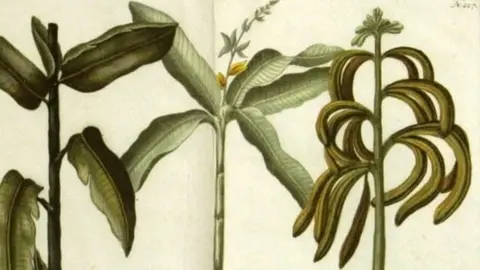 Wellcome
WellcomeIn 1633, Charles I was on the throne, Galileo Galilei was convicted of heresy (for holding the belief that the Earth revolves around the sun) and Samuel Pepys drew his first breath.
Also in 1633, on 10 April, a crowd gathered outside a shop in Holborn, in the city of London, to goggle at a peculiar new display.
Now ubiquitous in our fruit bowls and supermarkets, and always with the potential to cause a comedy slip, the banana was first seen and sold in Britain by Thomas Johnson - a botanist and apothecarist.
Records show he was the first person to sell bananas in England.
He wrote: "The fruit which I received was not ripe, but greene.
"This stalke with the fruit thereon I hanged up in my shop, were it became ripe about the beginning of May, and lasted until June."
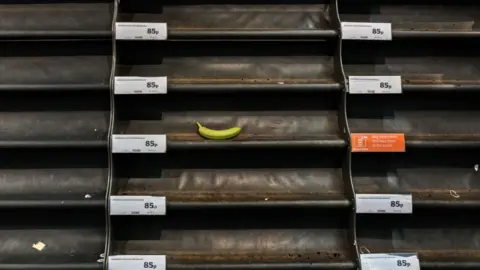 Getty Images
Getty ImagesJohnson described the fruit as "each of them the bignesse of a large beane some five inches long and an inch and a half in breadth. The stalk is short and like one's little finger".
"They hang with their heads down, but if you turn them up, they look like a boat. The husk is easily removed.
"The pulp is white, soft and tender and ate somewhat like a musk melon."
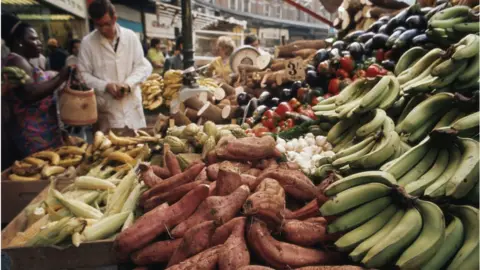 Getty Images
Getty ImagesThe bananas that attracted spectators to Johnson's shop are unlikely to be the same as the ones we put in our shopping trolleys.
Any banana now sold in British supermarkets will be descended from the Cavendish banana - and it is believed that Johnson's bananas came from Bermuda. We would probably refer to them today as plantains - or in the spelling of the day, "plantanes".
 Getty Images
Getty Images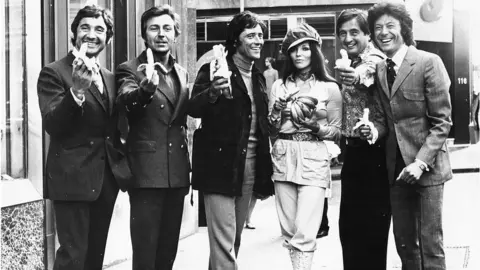 Getty Images
Getty ImagesIt still took a while for bananas to properly enter British culture.
The fruit's tropical origins, and its susceptibility to disease and shortages, had made it an exotic object.
Most people in England still had not seen a banana by the end of the 19th Century - when regular imports started from the Canary Islands.

Banana facts
- The most bananas snapped in one minute is 119 and was achieved by Andre Ortolf in Augsburg, Germany, on 23 March 2020
- Leather products like handbags or shoes can be polished with the inside of banana peels
- Bananas are botanically berries
- The ripening of bananas can be slowed by putting them in the fridge and sped up by putting them in a bag with tomatoes

Bananas took on a more symbolic role later - as something associated with peace and the end of war.
On 9 November 1940, the Minister of Food, Lord Woolton (he of the vegetable pie fame), ordered a complete ban on the import of bananas.
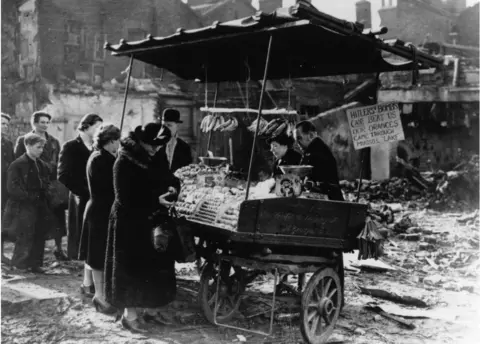 Getty Images
Getty ImagesThe tropical fruit had to be transported in refrigerated ships, which were needed for the war effort.
Plaintive wartime songs memorialised the banana. They included dance hall favourite When Can I Have a Banana Again? and I've Never Seen a Straight Banana.
Of course, Britons revealed their stiff upper lip and made do with a substitute called "mock banana".
Marguerite Patten who became known as "the queen of ration-book cuisine" had already created mock sausages (lentils), mock fish cakes (beans and anchovy paste) and mock oyster soup (artichokes).
It sounds less than convincing and consisted of boiled parsnip, mashed up with sugar and some banana extract.
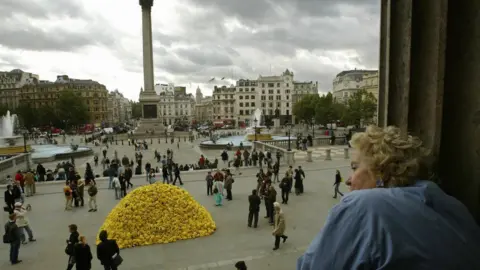 Getty Images
Getty ImagesIn the BBC's WW2 People's War - a user-submitted archive of memories of the war - one contributor from Dagenham remembers their mother winning a banana in a pub raffle in 1944.
"She had been offered 10 shillings for it but had refused. They told us that it wasn't ripe yet and so we would have to wait before it could be eaten. My sister and I probably asked our parents every day whether the banana was ready to eat. When the great day arrived we gathered round to have a taste of this little banana.
"I imagined that it would be something mouth-wateringly scrumptious. What I actually found myself eating was a hard, tasteless substance which I wouldn't have finished eating if I hadn't known what it was.
"I suspect that our impatience had prompted our parents to eat it before it had ripened but although that first banana was a great disappointment it did at least cure me of wanting another for a number of years."
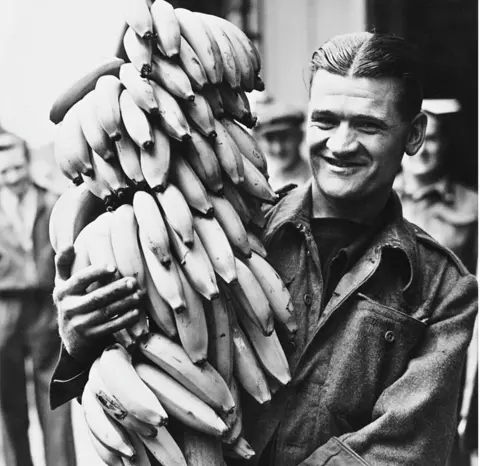 Getty Images
Getty ImagesIt was 1945 before bananas arrived in bulk again.
The first winter after the end of the war saw a Fyffe ship, the Tilapa, arrive from Kingston, Jamaica, loaded with a consignment of 10 million bananas.
Hundreds of children were there to greet it.
The fruit was earmarked for youngsters as a special treat - and many children had to be shown how to peel and eat a banana: from the top down, rather than side-on like corn on the cob.
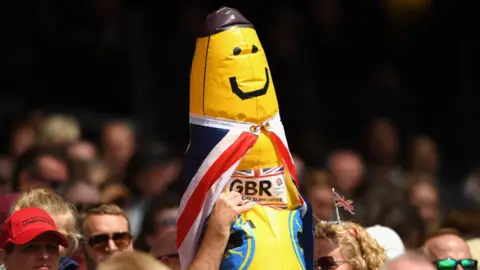 Getty Images
Getty ImagesNow, the banana is consistently one of the biggest sellers in British supermarkets - industry publication The Grocer has it third in terms of revenue (after strawberries and grapes), raking in £573m in 2023.
And London seems to have continued its relationship with bananas.
 Getty Images
Getty Images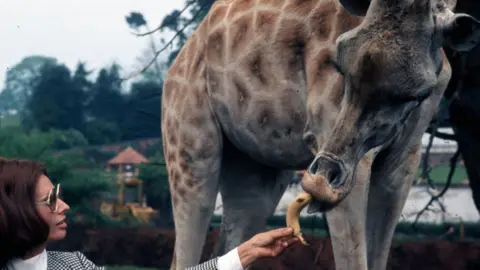 Getty Images
Getty ImagesIn 2007, artist Astrid Bin started to notice the number of discarded peels in the capital.
"Within a week of being in London I couldn't get my mind off these banana skins. Where were they coming from? Who was eating all these bananas and leaving the skins around? Why was it always bananas I was seeing, and not, say, oranges? Was it a sign? Was there something sinister going on?"
Bin began photographing the abandoned skins and in 2009, 1,000 pictures from the London Bananas archive were displayed in an exhibition in Shoreditch, London.
And artist Anna Chojnicka, a north London artist, bruises the skin to create elaborate drawings on bananas.
Completely... nuts.

Listen to the best of BBC Radio London on Sounds and follow BBC London on Facebook, X and Instagram. Send your story ideas to [email protected]
